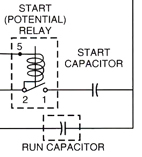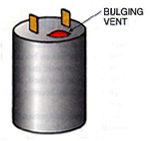The dispatcher called Bob and sent him to a new customer whose older heat pump was not working. It seems that the customer had called another contractor for the service call and was not pleased with the results, so Bob’s company was contacted. The weather was fairly cold, and the customer had switched the thermostat over to emergency heat.
Bob arrived at the job, a home in a very nice district, and met the owner. The owner described to Bob that the other company’s technician had tried to get the unit running and could not get the compressor to start. He said that the technician didn’t seem to know what he was doing while checking the compressor. He had left a quote to replace the compressor or the outdoor unit. The owner wanted a second opinion.

Figure 1. The contactor passes power to the compressor start circuit. It is normally operated by the 24-volt circuit furnished by the air handler or indoor unit. (Figures are from Refrigeration & Air Conditioning Technology, 5th Edition, by William Whitman, William Johnson, and John Tomczyk, published by Delmar Cengage Learning.)
Bob said, “I find it hard to follow behind another technician. He may have really been a good one. I don’t want to make a mistake.”
Btu Buddy then gave Bob some good advice: “Just do what you would normally do. Check the system in your normal way. Don’t let the last technician intimidate you. You are as good as anyone else when it comes to thinking through a problem. What are you going to do first?”
Bob said, “With the prior knowledge that the compressor would not start, I think I will start by checking all of the components that have to do with starting the compressor. This unit has a start relay and a start capacitor, as well as a contactor. I think I will remove the leads to the compressor and make sure the contactor tries to start the compressor (Figure 1).”

Figure 2. This is a capacitor tester. It reads out in the capacitance value of the capacitor - microfarads (mfd).
Bob then said to Btu Buddy, “I think I will check the start capacitor.”
He used a capacitor analyzer and checked the start capacitor. It checked OK. Then he checked the run capacitor and it was well within tolerance (Figure 2).
Bob then said, “All of this seems good. Everything is pointing to a bad compressor.”
Btu Buddy said, “You haven’t checked the start relay. It is a potential relay. Remember, the contactor just passes power to the starting circuit where the start relay is.”

Figure 3. This is the internal circuit of a potential relay. Notice the coil circuit is across terminals 2 and 5 and the contact circuit is across terminals 1 and 2.
Bob said, “I found a problem; the coil is open circuit. Hopefully this is all that is needed.”
Btu Buddy then said, “The last technician said the compressor would not start. The compressor would start with an open coil circuit, but the motor would stay in the start mode and shut down on the internal overload of the compressor. It would draw high amperage because it would stay in the start mode. I think you would want to try starting the compressor with one of those universal solid-state start kits that has its own start capacitor built in. If it starts and runs, you can make the decision to either just change the relay or use the universal solid-state starter.”
Bob removed the start capacitor from the system and fastened the universal solid-state start kit and pushed the disconnect closed. He had a clamp on ammeter on the common wire to check the compressor amperage. The compressor started and the amperage dropped back to full load amperage and the unit continued to run.
Bob then said, “I believe I will change the relay, the start capacitor, and the run capacitor. The old capacitors must have been stressed with the repeated starts. It would have been under a big load every time the compressor tried to start.”

Figure 4. This start capacitor has been stressed to the point that the rubber diaphragm is bulging. This capacitor is typically in a plastic case. Run capacitors are typically in metal cans and will bulge when stressed.
Bob then said, “I am going to go and explain this to the owner.”
When he returned, he told Btu Buddy, “I tried to keep from criticizing the other service technician. I explained that our company has well stocked service trucks and an ongoing program to keep us up-to-date on all service techniques. He told me that this would save him a lot of money and he believed the equipment would give more years of good service. I believe he will be calling us in the future. He also has a small manufacturing plant and he asked me if we did commercial systems. I told him we did. I think we will get more than residential business out of this service call.”
Btu Buddy said, “That was a good call for you and your company. The front office will appreciate the fact that you are bringing in more business from your service calls. It pays to make customers aware of all of your company’s services.”
Publication date:04/20/2009


Report Abusive Comment